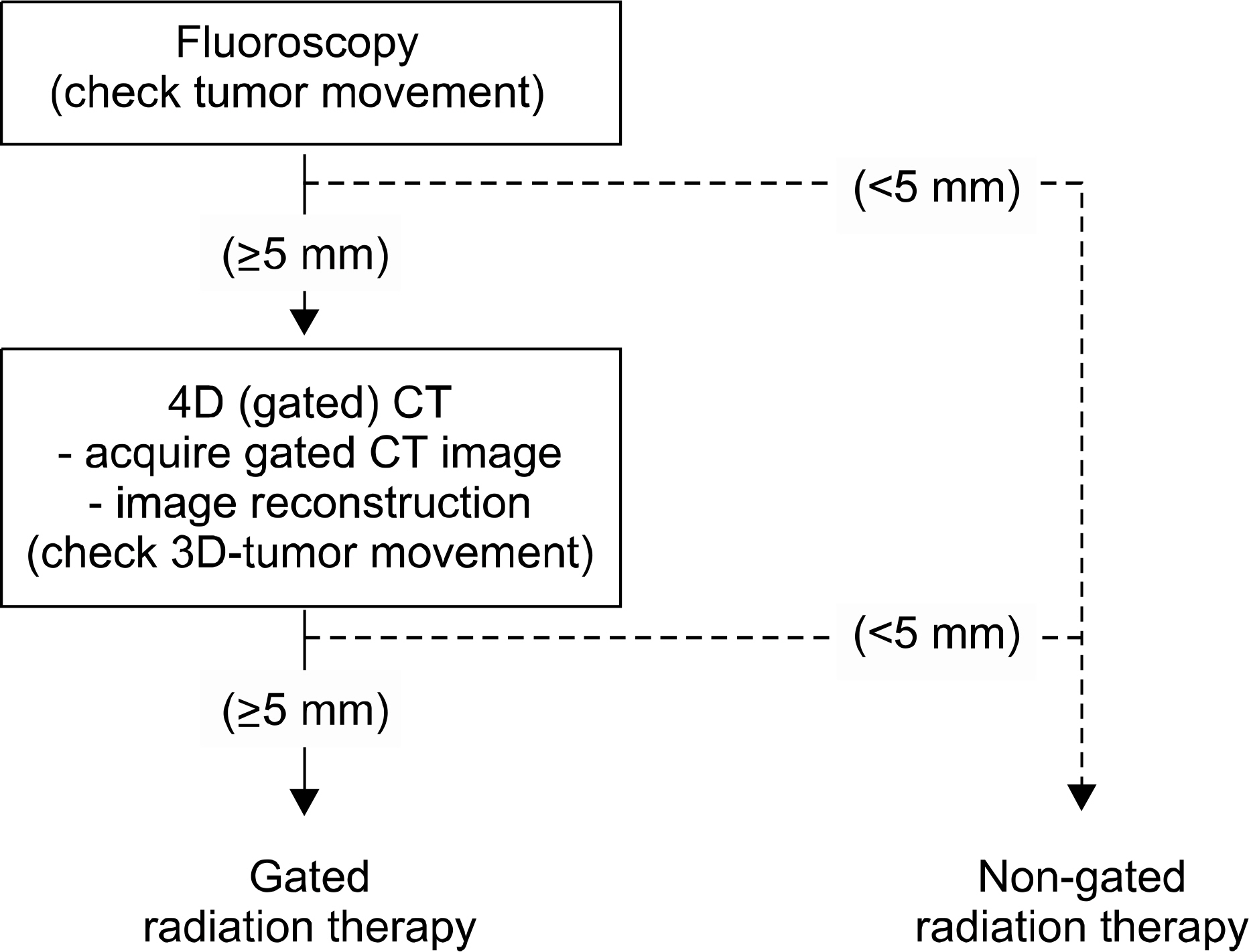J Lung Cancer.
2007 Jun;6(1):24-28. 10.6058/jlc.2007.6.1.24.
Assessment of Respiratory Tumor Movement using 4D Computed Tomography for Stereotactic Radiosurgery in Lung Tumor
- Affiliations
-
- 1Department of Radiation Oncology, Asan Medical Center, College of Medicine, University of Ulsan, Seoul, Korea. ekchoi@amc.seoul.kr
- 2Department of Radiation Oncology, Seoul National University Hospital, Seoul, Korea.
- KMID: 2200112
- DOI: http://doi.org/10.6058/jlc.2007.6.1.24
Abstract
-
PURPOSE : To assess the respiratory tumor movement using 4D-CT (4-dimensional computed tomography) for minimizing setup and target volume uncertainty of body-frame based stereotactic radiosurgery (SRS) in lung tumor.
MATERIALS AND METHODS
: Fifty-seven stereotactic radiation therapies with respiratory gating system in 44 patients (two targets in seven patients and three in three patients) were executed in Asan Medical Center from May 2005 to June 2006. We used respiratory gating system consisted of RPM (Real-time Positioning Management system, Varian, USA) and 4D-CT (GE healthcare, USA), if tumor movement was exceeding 5 mm by respiration on fluoroscopy. Accurate tumor movement on reconstructed 4D-CT image was determined for respiratory gated therapy. Respiratory gated therapy was done if tumor movement was exceeding 5 mm, and non-gated therapy was done if it was below 5 mm.
RESULTS
: Forty-five tumors were treated with supine position, and the other twelve were with prone position. Median tumor movement (3-dimensional) by respiration was 8.78+/-5.30 mm, and it was mostly affected by superior-inferior movement (8.53+/-5.23 mm). Tumor movements were different by tumor location, whether upper (5.38+/-2.85 mm) or lower (10.12+/-5.08 mm) lobe (p=0.015). Tumor movement was exceeding 5 mm in 27 (47.3%) tumors, and below 5 mm in 30 tumors in 4D-CT evaluation. Tumor movements on adopted respiratory gated phase were wholly below 5 mm, and its median value was 3.70+/-1.13 mm.
CONCLUSION
: Assessment of respiratory tumor movement using 4D-CT and gating system was helpful for minimizing target volume uncertainty. As a result, image-guided radiation therapy could improve the treatment accuracy of high precision stereotactic radiosurgery
MeSH Terms
Figure
Reference
-
References
1. Wulf J, Hadinger U, Oppitz U, et al. Stereotactic radiotherapy of targets in the lung and liver. Strahlenther Onkol. 2001; 177:645–655.
Article2. Nagata Y, Negoro Y, Aoki T, et al. Clinical outcomes of 3D conformal hypofractionated single high-dose radiotherapy for one or two lung tumors using a stereotactic body frame. Int J Radiat Oncol Biol Phys. 2002; 52:1041–1046.
Article3. Nakagawa K, Aoki Y, Tago M, et al. Megavoltage CT-assisted stereotactic radiosurgery for thoracic tumors: original research in the treatment of thoracic neoplasms. Int J Radiat Oncol Biol Phys. 2000; 48:449–457.
Article4. Hof H, Herfarth KK, Munter M, et al. Stereotactic single-dose radiotherapy of stage I nonsmall-cell lung cancer (NSCLC). Int J Radiat Oncol Biol Phys. 2003; 56:335–341.
Article5. Timmerman R, Papiez L, McGarry R, et al. Extracranial stereotactic radioablation: results of a phase I study in medically inoperable stage I nonsmall cell lung cancer. Chest. 2003; 124:1946–1955.6. SM Yoon, EK Choi, SW Lee, et al. Clinical results of stereotactic body frame based fractionated radiation therapy for primary or metastatic thoracic tumors. Acta Oncol. 2006; 45:1108–14.7. Dawson LA, Brock KK, Kazanjian S, et al. The reproducibility of organ position using active breathing control (ABC) during liver radiotherapy. Int J Radiat Oncol Biol Phys. 2001; 51:1410–1421.
Article8. Wilson EM, Williams FJ, Lyn BE, et al. Validation of active breathing control in patients with nonsmall-cell lung cancer to be treated with CHARTWEL. Int J Radiat Oncol Biol Phys. 2003; 57:864–874.
Article9. YL Suh, BY Yi, SD Ahn, et al. A feasibility study on the abdomen immobilization with air injected balloon blanket. Kor J Med Phys. 2002; 13:176–180.10. Shirato H, Shimizu S, Kitamura K, et al. Four-dimensional treatment planning and fluoroscopic realtime tumor tracking radiotherapy for moving tumor. Int J Radiat Oncol Biol Phys. 2000; 48:435–442.
Article11. Shirato H, Shimizu S, Kunieda T, et al. Physical aspects of a realtime tumor-tracking system for gated radiotherapy. Int J Radiat Oncol Biol Phys. 2000; 48:1187–1195.
Article12. Underberg RW, Lagerwaard FJ, Cuijpers JP, et al. Four-di-mensional CT scans for treatment planning in stereotactic radiotherapy for stage I lung cancer. Int J Radiat Oncol Biol Phys. 2004; 60:1283–1290.
Article13. Lu W, Ruchala KJ, Chen ML, et al. Real-time respiration monitoring using the radiotherapy treatment beam and four-di-mensional computed tomography (4DCT)–a conceptual study. Phys Med Biol. 2006; 51:4469–4495.
Article14. Rietzel E, Liu AK, Doppke KP, et al. Design of 4D treatment planning target volumes. Int J Radiat Oncol Biol Phys. 2006; 66:287–295.
Article15. Slotman BJ, Lagerwaard FJ, Senan S. 4D imaging for target definition in stereotactic radiotherapy for lung cancer. Acta Oncol. 2006; 45:966–972.
Article16. Britton KR, Starkschall G, Tucker SL, et al. Assessment of gross tumor volume regression and motion changes during radiotherapy for nonsmall-cell lung cancer as measured by four-dimensional computed tomography. Int J Radiat Oncol Biol Phys. 2007; 68:1036–1046.
Article17. Haasbeek CJ, Lagerwaard FJ, Cuijpers JP, et al. Is adaptive treatment planning required for stereotactic radiotherapy of stage I nonsmall-cell lung cancer? Int J Radiat Oncol Biol Phys. 2007; 67:1370–1374.
Article18. Nelson C, Starkschall G, Balter P, et al. Assessment of lung tumor motion and setup uncertainties using implanted fiducials. Int J Radiat Oncol Biol Phys. 2007; 67:915–923.
Article19. Underberg RW, Lagerwaard FJ, Slotman BJ, et al. Benefit of respiration-gated stereotactic radiotherapy for stage I lung cancer: an analysis of 4DCT datasets. Int J Radiat Oncol Biol Phys. 2005; 62:554–560.
Article20. Liu HH, Balter P, Tutt T, et al. Assessing respiration-induced tumor motion and internal target volume using four-dimensional computed tomography for radiotherapy of lung cancer. Int J Radiat Oncol Biol Phys. 2007; 68:531–540.
Article
- Full Text Links
- Actions
-
Cited
- CITED
-
- Close
- Share
- Similar articles
-
- Strategy of Respiratory Gated Radiation Therapy for Lung Cancer Patient in Stereotactic Radiosurgery : Phantom Study
- 4D CT for Stereotactic Radiosurgery of Lung Cancer : A case report
- Efficient approach for determining four-dimensional computed tomography-based internal target volume in stereotactic radiotherapy of lung cancer
- Four-Dimensional Thoracic CT in Free-Breathing Children
- Stereotactic Body Radiotherapy for Early Stage Lung Cancer


